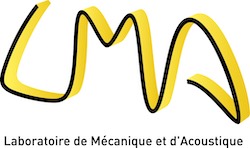Inorganic glasses are brittle materials and fail macroscopically in a purely elastic way at room temperature. Yet, under constrained deformation loadings, glasses experience permanent deformation, without damage nor fracture. As an example, this is the case for the hydrostatic compression test, where, for pressures around 25 GPa, permanent volume changes up to 16 % for silica glass are developed. This is also the case underneath an indenter during nano-indentation tests. There has been a long lasting controversy about the nature of the permanent indentation deformation mechanisms. Densification (permanent volume changes) underneath the imprint was deduced from changes in the refractive index, while observations of shear lines and pile-up around imprints suggested the occurrence of shear flow at room temperature.
Understanding and modelling the permanent deformation of glasses are necessary not only from a fundamental point of view but also from an engineering one. For the former, the relationships between the short-to-medium range order and the deformation mechanisms are required to understand the physics of amorphous materials and the possibility to design glasses with tailored properties. For the latter, glasses often fail from the surface flaws generated during processing or during service. Preventing failures in glass products requires to establish a link between the mechanical fields, the residual stresses, the occurrence of cracking systems and the propagation of cracks.
The aim of this presentation is to present recent advances of our group in these areas. The case of very different families of inorganic glasses (chalcogenide, metallic, oxide) will be presented to broaden the example of silica glass. Micro or nano-indentation experiments are conducted on different glasses. The mechanical response of the tests (load-displacement curves), as well as the residual imprints, are studied in detail. Densification or dilation as well shear plasticity underneath the indenter are investigated via complementary and dedicated procedures. Constitutive modelling is employed to discuss these experimental results via finite element analyses. In particular, the densification process is properly modelled thanks to recent in situ and ex situ experiments of hydrostatic compression. The roles of shear and shear flow will then be discussed with respect to nano- indentation results.
Different aspects of the mechanical behaviour will be addressed, including permanent deformation, viscoplasticity, viscoelasticity, fracture toughness, shear localisation...
References
- V. Keryvin. Indentation of bulk metallic glasses : Relationships between shear bands observed around the prints and hardness. Acta Mater., 55(8) (2007) 2565-2578.
- H. Ji et al. Densification of window glass under very high pressure and its relevance to Vickers indentation, Scripta Mater. 55 (12) (2006) 1159–1162. C. Bernard et al. Indentation creep of window glass around glass transition. Mech. Mater. 42 (2010) 196-206
- Y.-F. Niu et al. Locally Enhanced Dissolution Rate as a Probe for Nanocontact-Induced Densification in Oxide Glasses. Langmuir 28 (29) (2012)
- 10733-10740
- L. Charleux et al. A method for measuring the contact area in instrumented indentation testing by tip scanning probe microscopy imaging. Acta
- Mater., 70 (2014) 249–258.
- V. Keryvin et al. Constitutive modelling of the densification process in silica glass under hydrostatic compression. Acta Mater., 62 (2014) 250–257.
- J.-S. Brest et al. Insight into plasticity mechanisms in metallic glasses by means of a brazilian test and numerical simulation. J. All. Comp., 586 (2014) S236–S241.
- Y. Gueguen et al. A relationship between non-exponential stress relaxation and delayed elasticity in the viscoelastic process in amorphous solids : Illustration on a chalcogenide glass. Mech. Mater., 85 (2015) 47-56
- C. Bernard et al. A sequential pre-cracking procedure to measure the mod-I fracture toughness of ultra pure bulk metallic glasses. Scripta Mater. 141 (2017) 58-61
- V. Keryvin et al. Mechanical behavior of fully densified silica glass under Vickers indentation. Acta Mater., 129 (2017) 492-499.


